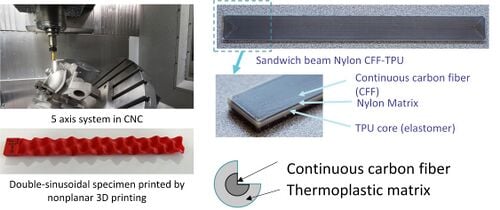
When you fail, ask yourself: what is your original aspiration? when you succeed, ask gain: what is your original aspiration? and always keep it true
Academic and Professional Background[edit | edit source]
A Ph.D. candidate at the University of Lorraine studying with Dr. Hakim Boudaoud and specializing in the vibration characterization of additively manufactured composite structures with in-depth knowledge of mechanics of solid, damping of materials and structures, as well as hands-on experience in static/dynamic mechanical testing and multi-material additive manufacturing. Completed Bachelor's program in Aeronautic Engineering and Master's program in Mechanics of Materials and Structures. My passion is extending the use of additive manufacturing in composite structures and vibration.
Currently working in the research team on innovation process (ERPI, EA 3767) and the Laboratory of Microstructures and Mechanics of Materials (LEM3, UMR 7239 CNRS) of the University of Lorraine, I will also join the FAST group of Dr. Joshua M. Pearce at the Western University as a visiting graduate student.
Research Interests[edit | edit source]
- Vibration | Damping
- Additive manufacturing | Fused filament fabrication
- Composite materials | Continuous fiber reinforced structure
- Open-source hardware and software
Publications[edit | edit source]
Journal article:[edit | edit source]
- F. Xue, G. Robin, H. Boudaoud, F. A. Cruz Sanchez, and E. M. Daya, “General Methodology to Investigate the Effect of Process Parameters on the Vibration Properties of Structures Produced by Additive Manufacturing Using Fused Filament Fabrication,” JOM, Jan. 2022, doi: 10.1007/s11837-021-05051-9.
Journal article under review:[edit | edit source]
- F. Xue, G. Robin, H. Boudaoud, F. A. Cruz Sanchez, and E. M. Daya, “Optimization of vibration damping properties of additively manufactured thermoplastic polyurethane structures,” 3d printing and additive manufacturing.
Conference proceedings:[edit | edit source]
- F. Xue, G. Robin, H. Boudaoud, F. A. Cruz Sanchez, and E. M. Daya, "Characterization and optimization of the vibration properties of mono- and multi-material structures printed by fused filament fabrication," Congrès Français de Mécanique 2022.
- F. Xue, G. Robin, H. Boudaoud, F. A. Cruz Sanchez, and E. M. Daya, "Influence of layer thickness and nozzle temperature on the interlocking adhesion strength of additive manufactured multi-material interface," Solid Freeform Fabrication 2022.
- F. Xue, G. Robin, H. Boudaoud, F. A. Cruz Sanchez, and E. M. Daya, “Effect of Process Parameters on the Vibration Properties of PLA Structure Fabricated by Additive Manufacturing,” Solid Freeform Fabrication 2021. doi: 10.26153/tsw/17573.
Projects[edit | edit source]
5-axis 3D printing of continuous fiber reinforced composite structure[edit | edit source]

This project aims to develop a multi-material, 5-axis 3D printer that is capable of printing both continuous fibers and viscoelastic polymers. The integration of continuous fibers and flexible plastics allows for a better balance between mechanical strength and damping of the printed structures. The introduction of the Cartesian 5-axis system will allow printing on non-planar surfaces, which will release the full capacity of additive manufacturing in creating complex structures.
Optimization of the adhesion strength of dissimilar materials in multi-material additive manufacturing[edit | edit source]

Achieving adequate adhesion strength at multi-material interfaces is always a challenge in material extrusion additive manufacturing (MEAM), especially when the materials have very different chemical affinities. This project investigated the adhesion mechanism of multi-material interfaces in MEAM from a micro-geometric perspective using butt-joint tensile test and microscope observation. By optimizing the layer thickness and nozzle temperature, the interface adhesion strength between dissimilar materials was significantly increased without increasing the printing time or fabrication complexity.
Vibration characterization of additively manufactured structures[edit | edit source]

As the application of additive manufacturing (AM) continues to expand, printed products are inevitably exposed to dynamic mechanical loads and vibrations. However, most studies in the literature devoted to characterizing and optimize the static mechanical properties of AM parts, the vibration properties of final parts are scarcely studied. In this context, this project aimed to characterize the vibration damping properties of FDM printed mono-material viscoelastic beams and multi-material sandwich structures. Firstly, to optimize the damping capacity of FDM printed viscoelastic structure, the effect of four process parameters, raster angle, nozzle temperature, layer height and deposition speed on the vibration properties of beams printed by viscoelastic material were investigated. Using Taguchi method, it’s found that the nozzle temperature has the most significant impact on the resonant frequencies and the loss factors. Then, composite sandwich structures with two rigid face-sheets and one viscoelastic core were printed under the identified optimal process parameter settings. It’s approved that FDM can fabricate mono- and multi-material structures with excellent reproducibility in terms of vibration properties. By introducing viscoelastic materials into rigid structure, the damping capacity of structure can be effectively improved without significantly reducing the resonant frequency.
F. Xue, G. Robin, H. Boudaoud, F. A. Cruz Sanchez, and E. M. Daya, “General Methodology to Investigate the Effect of Process Parameters on the Vibration Properties of Structures Produced by Additive Manufacturing Using Fused Filament Fabrication,” JOM, Jan. 2022, doi: 10.1007/s11837-021-05051-9.
Co-authors – Collaborators[edit | edit source]
| Dr. Hakim Boudaoud | Dr. Joshua M. Pearce | Dr. Guillaume Robin |
| Dr. Fabio Cruz. Alberto Sanchez | Prof. El Mostafa Daya |